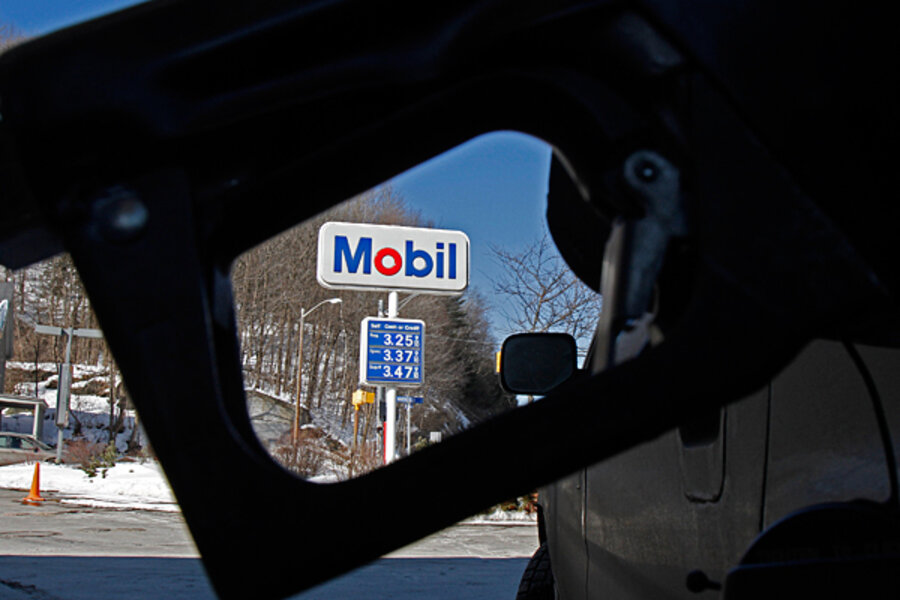Should US draw on strategic reserves to temper rise in oil prices? (video)
| New York
The last time the US decided to embark on a major program to release oil from the Strategic Petroleum Reserve was in 2000, when President Bill Clinton, concerned about the price of oil going into the winter, opened up the spigots.
With oil now hovering at about $100 a barrel and questions springing up about possible production declines in Libya, the White House warned the oil markets that strategic reserves of oil might be used.
“We have the capacity to act in case of a major disruption,” said White House Press Secretary Jay Carney. “Right now we are monitoring the situation with the IEA [International Energy Agency] and discussing what is happening.”
Economists say selling oil from the reserves could result in lower prices over the short term. But they are not sure that would work for a longer period unless it were coordinated with oil-producing nations, which could simply pump less oil to keep prices from falling.
On Thursday, Treasury Secretary Tim Geithner, without saying the Obama administration intended to open up the Strategic Petroleum Reserve (SPR), stated that the US, Europe, Japan, and China all have significant emergency stockpiles.
“Hopefully, by reminding people of that and calling attention to the fact there is a fair amount of excess capacity in parts of OPEC – hopefully that will make it less likely the market starts to build in higher prices over time,” Mr. Geithner said at a White House meeting with corporate leaders.
Price drop at end of day
The prospect of oil being released from reserves in the US, Europe, Japan, and China caused the oil markets to drop in the last hour of trading Thursday. By the end of the day, the price was below $97 a barrel after hitting $103 first thing in the morning.
Before Geithner’s warning, some Democratic lawmakers from the Northeast wrote President Obama to ask him to let the oil flow from the SPR. The stockpile contains about 727 million barrels, about a 35-day supply of oil.
“Releasing even a small fraction of that oil could have a significant impact on speculation in the marketplace and on prices. It would also remind the world that the US is ready, willing and able to use the SPR aggressively and effectively if needed,” said the letter written by Reps. Ed Markey of Massachusetts, Rosa Delauro of Connecticut, and Peter Welch of Vermont.
At a Monitor-sponsored breakfast for reporters Thursday, Austan Goolsbee, chairman of the president’s Council of Economic Advisors, said the greatest impact from rising oil prices on the economy occurs when the prices stay high for a long period of time.
Mr. Goolsbee added that if the price of oil stays where it is now, it will not harm the economy.
However, some other energy observers are concerned that a rising price of oil could have an adverse effect on the economy. For example, in July 2008, oil prices peaked at $140 a barrel, sucking money out of consumers’ wallets. Some economists say that price spike hurt consumer confidence, which was then further undermined later by the housing and financial collapse.
Danger of 'oil price shock'
“In light of the role oil played in the recession in 2008-2009, this bears scrutiny,” says Tim Considine, a professor of energy economics at the School of Energy Resources at the University of Wyoming in Laramie. “The last thing we need is another oil price shock.”
Goolsbee says consumers are now confident again. Their confidence level on jobs, for example, is the highest since 1984, he says. “So we start from a more optimistic place for 2011 than we have been in some time,” he said.
In addition, he argues the US has become more energy efficient than it was in past oil spikes.
“Fuel costs are something like 10 percent or less of consumer expenditures, and overall inflation – consumer price index inflation – remains very low,” he said.
It is not clear that will remain the case, at least as far as energy is concerned. Nationally, the price of gasoline at the pump moved up 4 cents a gallon overnight, according to AAA, the national motorists’ club. In the past month, the rise is 12 cents a gallon.
Rising prices alone should not prompt the US to release oil from the SPR, argues John Felmy, an economist at the American Petroleum Institute in Washington.
“If we have a legitimate emergency, absolutely release oil, but not for price manipulation,” says Mr. Felmy, who adds that any release of oil would have only a short-term effect.
For example, he says, after President Clinton released oil from the SPR, prices came down. But just a month later, OPEC cut production. “This effectively offset the release,” says Felmy. “The administration has to understand Saudi Arabia’s and OPEC’s plans, and the International Energy Agency has to be a part of the emergency response.”





